Webinar Recap: A Guide to Shipping Cart Optimization
Watch a replay and learn the key takeaways from iDrive’s webinar on Shipping Cart Optimization, presented by Alex Frayer.
Did you know that 70% of shoppers abandon their carts? The reasons often boil down to unexpected shipping costs, long delivery times, or overly complex checkout processes. Essentially, customers lose interest when getting the items they want becomes a hassle.
However, eCommerce businesses can tackle these pain points head-on with checkout optimization. Streamlining the shipping and checkout experience can reduce cart abandonment, boost conversions, and build lasting customer loyalty.
In this article, we’ll dive into the key takeaways from iDrive’s webinar on Shipping Cart Optimization, presented by Alex Frayer.
Speaker Highlights: Alex Frayer

The key speaker for this webinar was Alex Frayer, a Logistics Customer Success Manager at iDrive who specializes in helping clients optimize their shipping processes. With extensive experience in shipping support and expertise in logistics solutions, Frayer has successfully resolved complex logistics challenges and developed diversified shipping strategies tailored to client needs.
Key Takeaways
1. Understanding Cart Abandonment
Brands invest significant resources in marketing and branding to drive customers to their websites and encourage them to proceed to checkout. However, when customers abandon their carts, it leads to wasted acquisition spend. So, why do so many customers abandon their purchases?
Studies show that 48% do so due to unexpected shipping costs, 22% because of long delivery times, and 17% due to complex checkout processes.
This highlights the critical role of shipping cart optimization in the shopping journey. Simply attracting customers to your site isn’t enough—converting them requires addressing these pain points. Frayer emphasized that acquisition is only half the battle, with 50% of the customer experience between checkout and delivery.
iDrive employs three key shipping strategies to enhance the customer experience, ultimately driving increased conversions, reducing returns, and fostering customer loyalty:
- Shipping as a Revenue Stream – For smaller brands, shipping is a way to make money. By charging for shipping, brands can cover their costs or make a margin. It’s a smart way to keep things sustainable while being transparent with customers.
- Shipping as a Competitive Requirement – Offering free or fast shipping has become necessary for larger brands to remain competitive in a market dominated by giants like Amazon. To stay ahead, these brands focus on meeting or exceeding customer expectations for speed and cost.
- Shipping as a Necessity – Most brands fall into this category, where the goal is to find a balance. You want to drive down shipping costs without sacrificing customer experience. It’s all about ensuring your customers are happy while controlling costs.
At iDrive, each brand is carefully evaluated to determine the most effective strategy for optimizing their shipping cart. This tailored approach ensures that the right strategy is in place to meet your goals, improve your customer experience, and keep your business growing!
2. Enhancing the Checkout Experience
Frayer shared four keys to creating an excellent cart experience, and they’re all about making things easier for your customers while boosting conversions. Here’s how you can enhance your checkout process:
Three clear shipping options
This is tied to consumer psychology; three choices keep things clear, concise, and easy to digest.
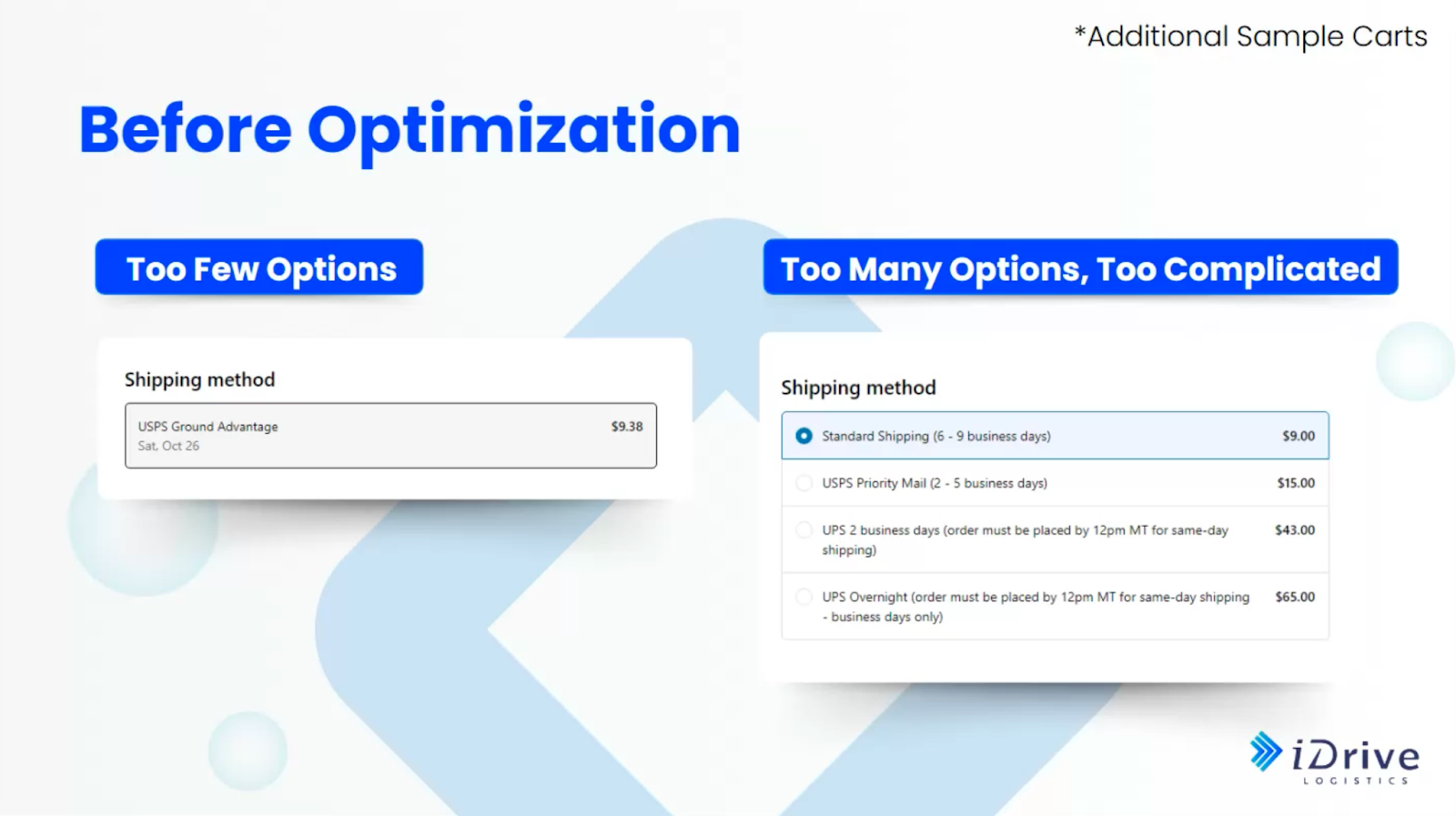
Here’s a better explanation for this:
- Choice Overload: Too many options can overwhelm your customers, lowering satisfaction. Studies show that people with too many choices often end up less happy with their decisions.
- Single-Choice Aversion: A single, attractive option with nothing to compare it to can make customers hesitate. And hesitation? Well, it usually leads to cart abandonment.
- The Decoy Effect: When you give customers three choices, they feel more confident about their selection. It gives them a sense of control, which helps them feel good about their decision.
Simple naming conventions
Clear names for your shipping options go a long way. Frayer recommends using terms like economy ground, expedited, and express.
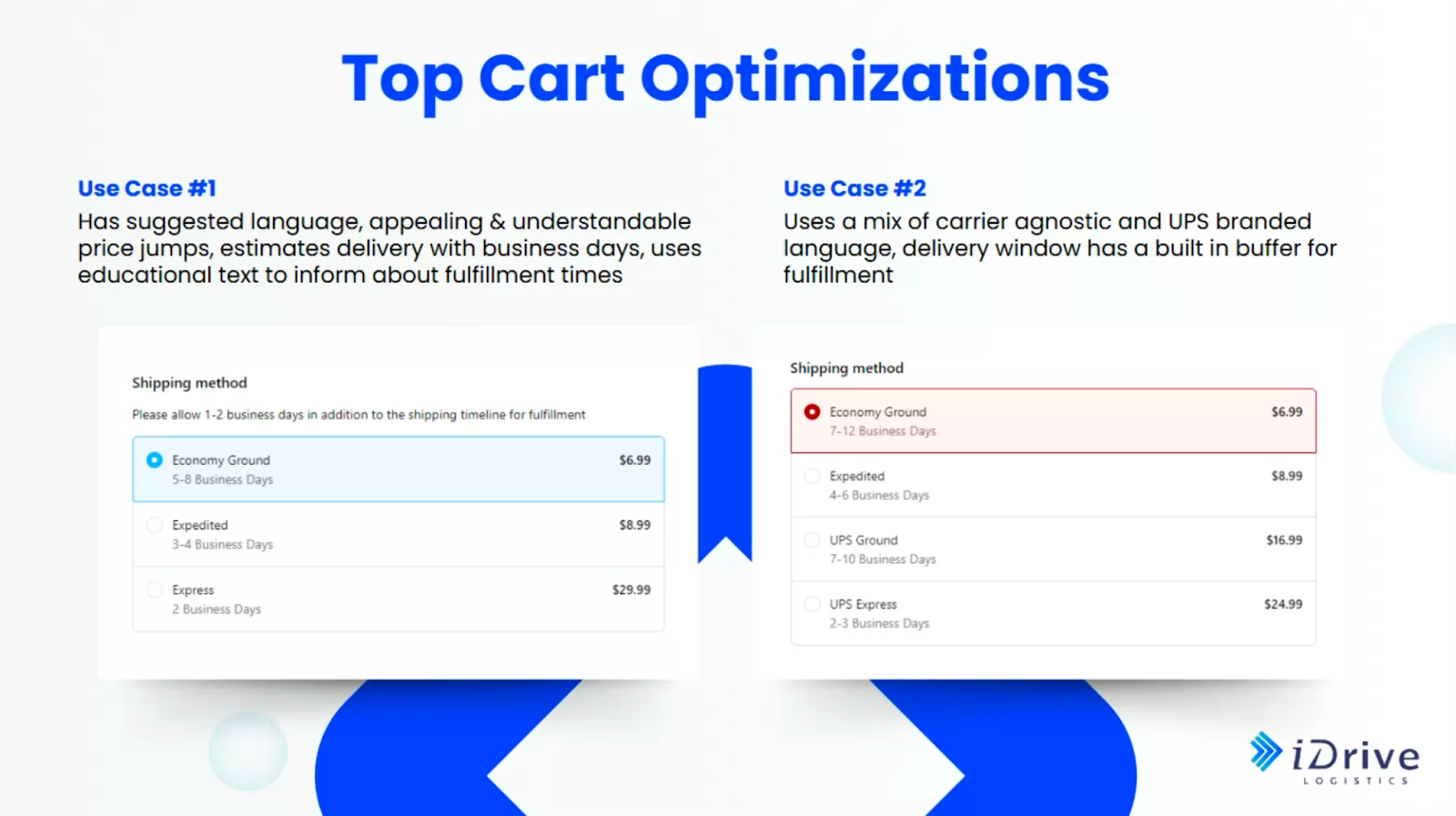
These names communicate the delivery speed without requiring your customers to overthink it. Plus, this naming convention helps guide customers toward the middle option, typically where the best customer experience lives. Frayer noted that the specific carriers aren’t as important here—it’s all about clarity!
Strategic pricing
Strategic pricing makes a real difference for consumers. Here’s how Frayer suggests structuring your costs:
- Economy Ground should be the most competitive, offering the best value without sacrificing the customer experience.
- Expedited can be priced slightly higher, creating a more premium feel without being too far removed from the ground option.
- Express should not be subsidized, as it’s typically chosen by customers who need something fast and are willing to pay for that speed.
Realistic delivery windows
Setting delivery expectations upfront is crucial, and Frayer recommends under-promising and over-delivering. How does this work?
Show a longer delivery window to give yourself a buffer, and use educational text to explain that extra time may be needed for fulfillment. This transparency helps customers understand what’s happening behind the scenes and creates a better overall experience.
Case Study: A Closer Look at Implementation
iDrive’s client has graciously shared stellar results after optimizing their Shopify checkout process.
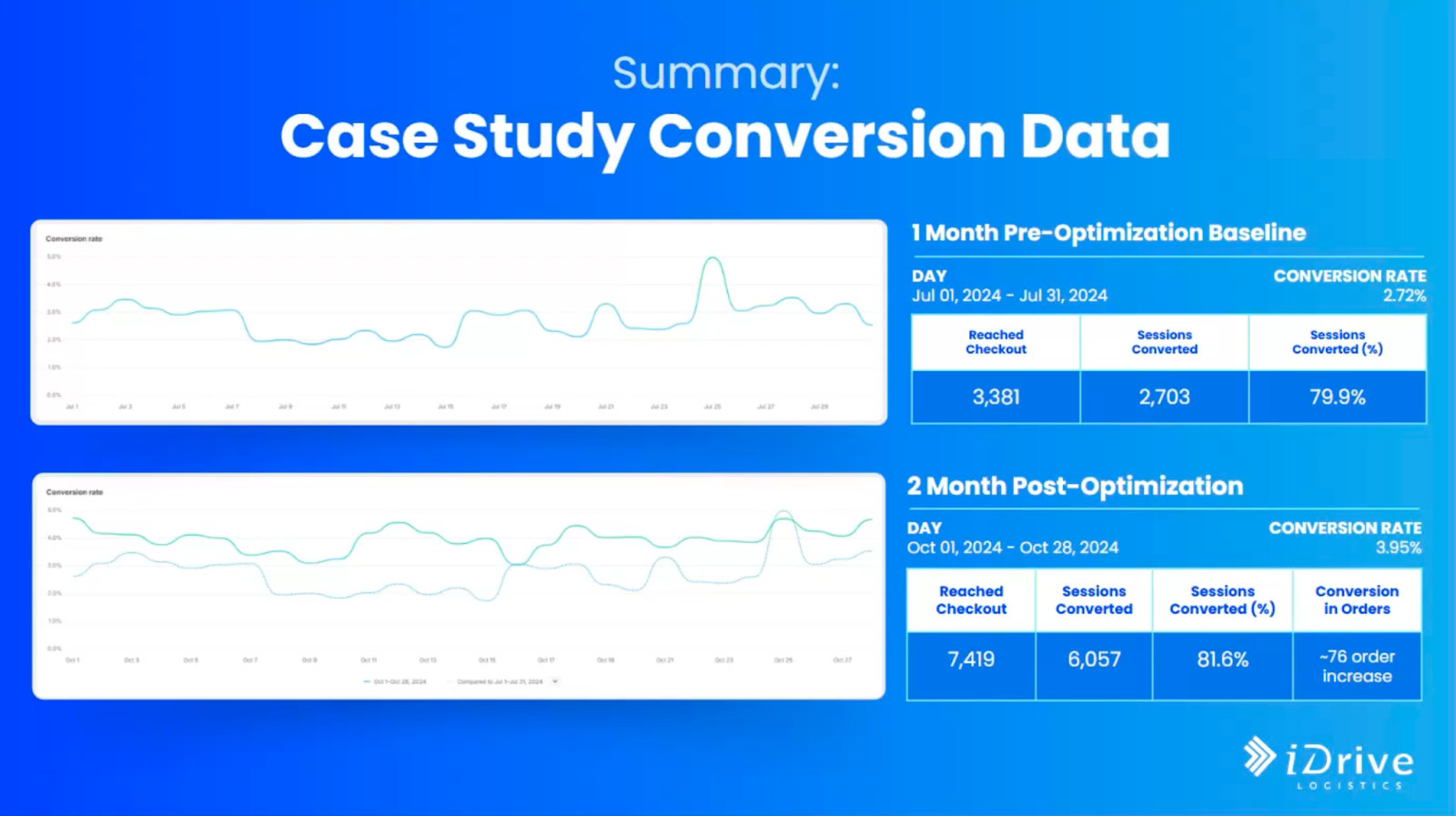
In July, the overall conversion rate was 2.72%, with 79.9% reaching checkout proceeding to purchase. Two months later, following the optimization, the conversion rate rose to 3.95%, and the checkout-to-purchase conversion increased to 81.6%.
While this may seem like a slight percentage increase, it resulted in 76 more orders. This data highlights the direct correlation between optimized checkout processes and increased sales, showing the huge impact of shipping cart optimization on overall business performance.
Keep in mind that optimization isn’t a one-size-fits-all approach. At iDrive Logistics, we tailor our optimization process to each client, considering their unique shipping profile, carrier performance, and shipping costs to ensure the best results for every brand.
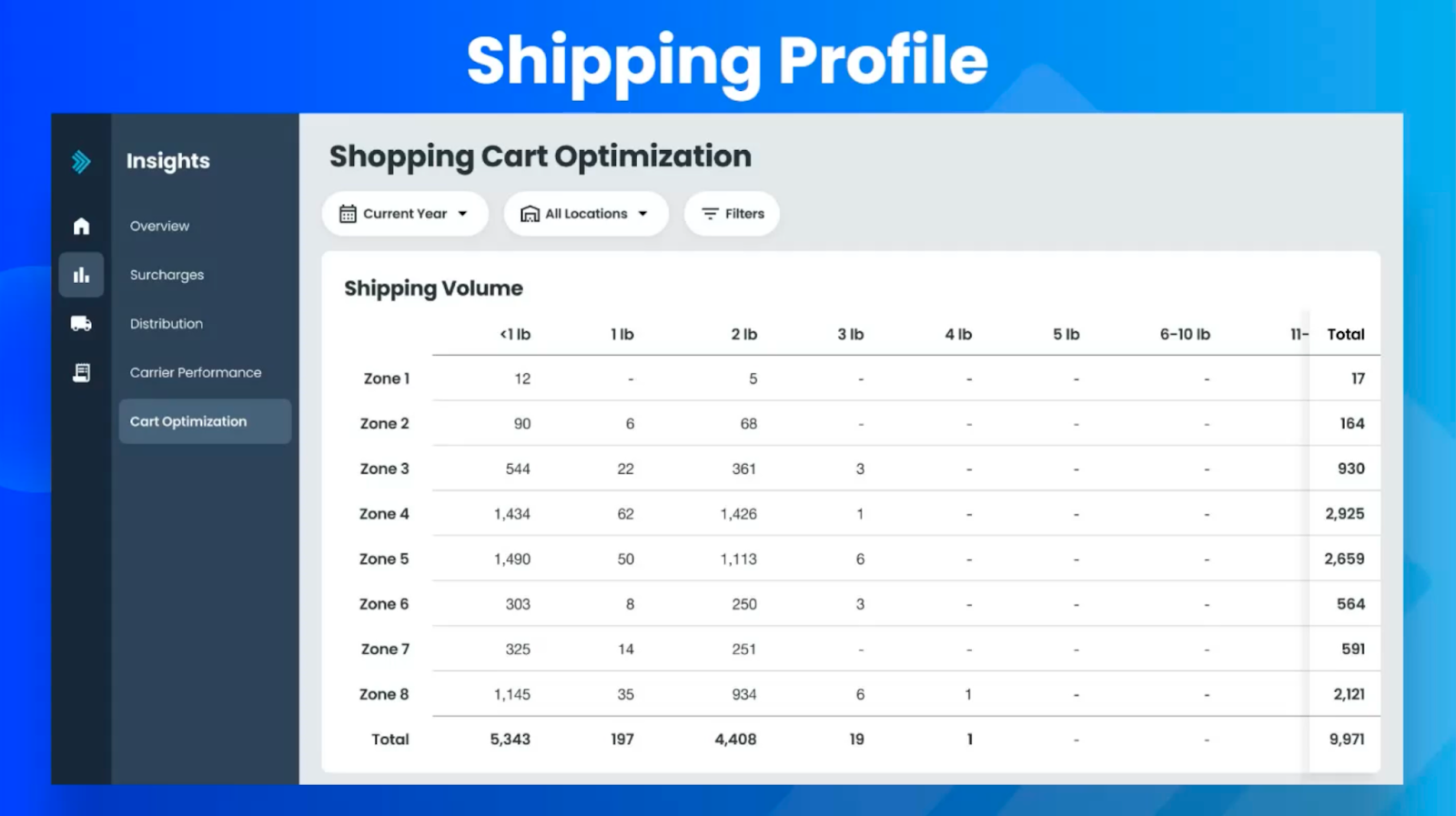
We’re also excited to launch a new technology at the start of the year, designed to streamline the process further. This tool will allow brands to instantly view their shipping profiles and easily optimize the checkout experience, providing a seamless and efficient solution.
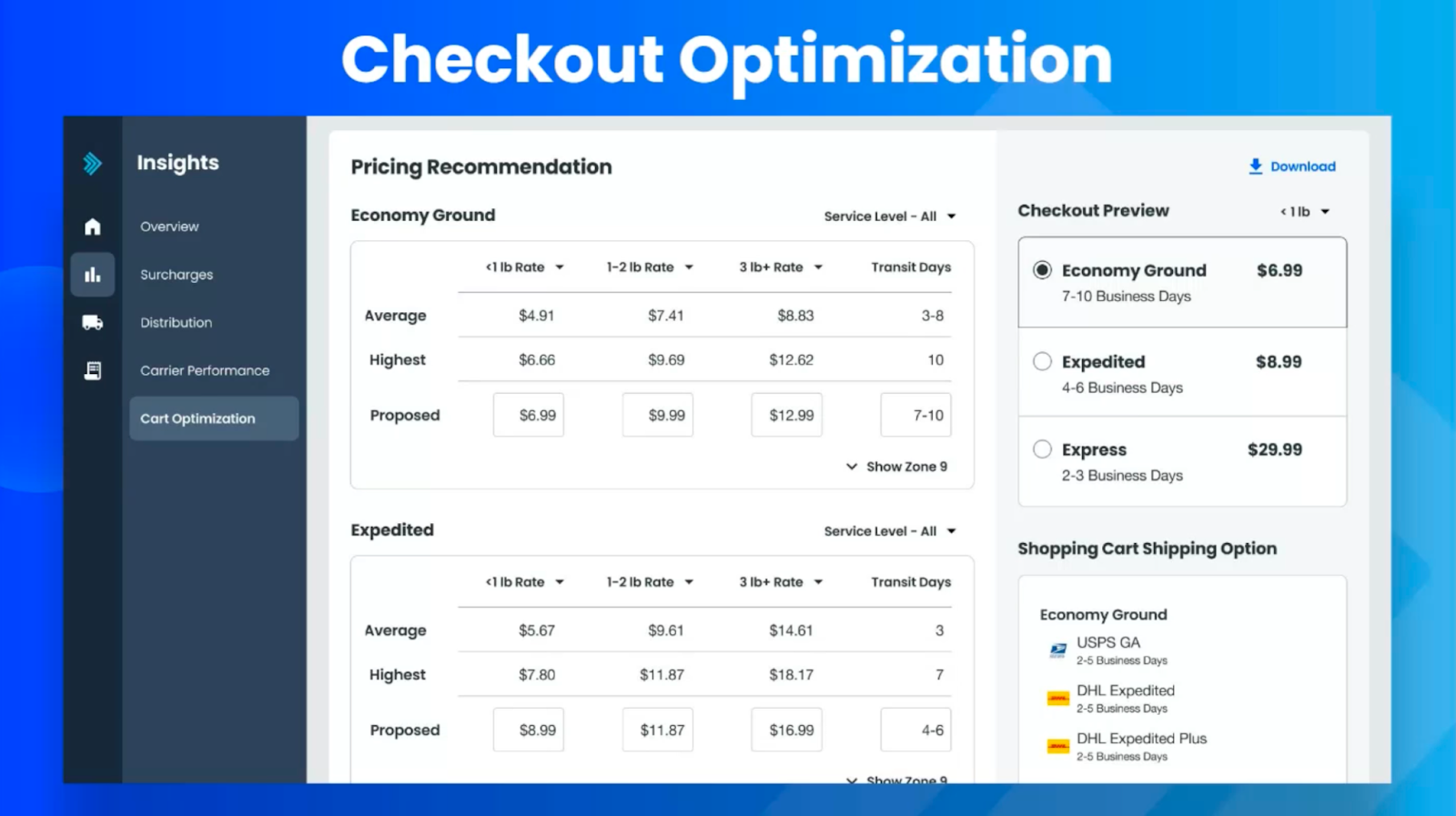
3. 4 Post-Purchase Strategies To Implement
As mentioned earlier, half of the customer experience happens between checkout and delivery, and this phase can significantly impact customer loyalty and repeat purchases. It’s a continuous journey; keeping it positive and engaging for your customers is essential. Once a customer has completed their purchase, strengthen your relationship by implementing the following strategies:
1. Send Personalized Thank-You Messages
A heartfelt thank-you email after a purchase goes a long way. Personalizing this message makes your customer feel valued and appreciated. It’s a simple gesture that can turn a one-time buyer into a long-term customer.
2. Offer Order Tracking and Updates
Keeping customers in the loop during shipping and fulfillment allows them to feel in control. Providing tracking information and regular updates helps ease any anxiety and ensures they’re never left wondering where their order is. The more they know, the more confident they’ll feel in their purchase and your service.
3. Create Loyalty Programs
Encourage repeat purchases by offering incentives to returning customers. Loyalty programs—such as points, discounts, or exclusive offers—can make customers feel valued and give them a reason to return. Offering early access to new products or collections further deepens their connection to your brand.
4. Request Feedback and Reviews
Nothing says “you’re valued” like asking your customers about their experience. Gathering feedback helps you improve your services and shows that you care about providing the best experience. Plus, offering an incentive for reviews can motivate customers to share their thoughts and return to your store for future purchases.
Q&A
Does the iDrive platform automatically use the cheapest rate per service level available?
Yes, the iDrive platform pulls data from your invoices to reflect precisely what you’re paying.
For example, if you’re using a mix of ground services and DHL, the platform calculates the average cost of those service levels. When choosing the cheapest rate, you must review each service individually to determine which offers the best rate based on the weight and shipping options.
How do you decide what to subsidize for customers, particularly regarding the three shipping lanes?
When deciding which lane to subsidize, we recommend focusing on the economy lane. If shipping costs deter customers from completing their purchase, consider subsidizing this lane by a small amount, such as $1 or 50 cents. Why? The cost difference between subsidizing the economy lane is relatively small while subsidizing higher-tier options like Express can be much more expensive (around $5).
Alternatively, if you’re offering free shipping for orders over a certain weight (e.g., three pounds), you can apply that threshold to subsidize the costs of expedited or express shipping. This means your customers can enjoy free shipping on orders over three pounds. Still, if they opt for faster shipping, you can reduce the additional cost (e.g., $3 instead of $6). This encourages them to choose quicker delivery at a lower cost to you.
Where should you place free shipping options in the order of the cart?
It is important to place free shipping options in the cart. Position them as part of the first line of the checkout process. When determining your free shipping threshold, consider your Average Order Value (AOV).
For example, if your AOV is $25 for two items, set the threshold to $30, so customers need to add a third item to qualify for free shipping. This strategy helps increase your AOV, which can cover the shipping costs and boost your margin on each order.
What percentage of customers select different shipping speeds after optimizing a shipping cart?
After optimizing a shipping cart, most customers still prefer the economy lane, which accounts for 80-90% of selections. The expedited lane sees around 7-20% of customers, depending on factors like product type and urgency. The express lane is selected by 1-6% of customers. This is a small group, but they often urgently need their order and are willing to pay for faster delivery.
Watch the Webinar Replay
Want to revisit Frayer’s insights on Shipping Cart Optimization? You can watch the replay below:
Or, feel free to bookmark this page to reference it whenever you need a refresher on the best practices, tools, and strategies discussed.
Download the Slides
Deliver a Smooth Checkout Experience with iDrive Logistics
Looking to optimize your shipping cart to boost conversions and create a better customer experience?
Review your checkout process today and see how you can apply these strategies! With some adjustments—like offering clear shipping options, setting realistic delivery times, and making pricing transparent—you can reduce cart abandonment and turn your one-time shoppers into repeat customers.
If you need extra help optimizing your shipping cart, we’re here to help! Connect with our team of shipping and fulfillment experts, and let’s make your checkout process seamless.
Related articles
-
Enhancing Customer Loyalty Through Exceptional Shipping Experiences
Read moreHow Shipping Insurance Can Help SMBs Compete in the Age of E-commerce
-
Navigating the Complex Waters of Parcel Sourcing Strategies
Read moreInsights from Episode 8 of "Parcel Perspectives"
-
Navigating the Peaks and Valleys of Reverse Logistics: Insights for E-Commerce Businesses
Read moreReturns are ian opportunity for businesses to optimize operations, build brand loyalty, and embrace sustainability in a meaningful way.
